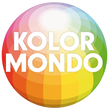I did not know that color can be understood in 3D. Do you?
This is the first blog post of Kolormondo. So let me start by introducing myself; I am Nicoline Kinch, the inventor and owner of Kolormondo, the 3D color wheel. If you contact us on any question you might have on our color globes, I will, most probably, be in this end to answer you.
What is Kolormondo?
Although we sell our 3D color wheels all over the world, and know that there is a great interest for color theory in so many industries, this is still a very small company, based in my home in a 250 year old cottage in the countryside outside Stockholm, Sweden.
15 years ago, I knew nothing on color. In retrospect, I realize I was “color illiterate”, ie I had no way to “read” and understand colors. What was the difference between one brown and another? It was annoying since buying clothes, it was difficult to see what colors would match eachother. So black would be a safe choice…… How booring is that!
You can find the full story of the 3D color wheel here: https://kolormondo.com/pages/about.
Is there a thing called color theory?
After 15 years of working with color theory, am I an expert? I wish! But color theory is complex. I rather see myself as a facilitator of color theory. For anyone who wants to learn to do for instance color design, color printing, hair color, create a colorful home – or just enjoy color in art - Kolormondo is an excellent introduction. It is like an ABC book for color theory, very often providing an aha-moment.
Is Kolormondo the ultimate 3D color wheel?
Kolormondo is a physical 3D color wheel. But first and foremost, it is a concept. Imagine a globe which has a white North pole and a black South pole. Around the equator you will have the full, vivid colors, green, yellow, orange, red etc. So going north all those colors becomes paler, and finally all meet at the North pole. Similarly, they get darker and darker towards the black Soth pole. There you have already 2 dimensions. The Hue is going around the equator, and the Value is going from dark to light. So far it is easy and obvious. However, the 3D happens when you look at what is called Saturation, I e when you go inwards in the globe. Between north and south, you can imagine there is a pillar of grey, in the very middle you would thus have a middle grey. If you go from let’s say red, towards the middle, the color will be less and less saturated, ie more and more grey. Voila, there you are, “aha”! now you can see that all the colors gradually move into eachother in all directions. It is like when you finish a jigsaw puzzle, and it suddenly makes sense.
So, to simplify color theory and profit from the intuitiveness of the Kolormondo 3D color wheel, lets use
- “around” instead of hue
- “up/down” instead of value and
- “in/out” instead of saturation.
Let’s have a color language that everybody can understand. And talking about that, the name Kolormondo comes from the language Esperanto. That is logical and easy to learn. It means simply “world of color”.
Introducing myself – oh! I forgot. More fun to talk about my 3D color wheel and how it relates to color theory. Will come back to that later.
I am happy to answer any questions. Contact me on nicoline@kolormondo.com
I’m an optical engineer, so I’ve been tangentially exposed, but had never studied the language or dimensions until just now.
Yesterday I had three dimensional vision of something similar to your kolormondo with black and white being the poles. I was trying to figure out how saturation and value would work. I Googled three-dimensional color sphere and found you! I was so excited, and can’t wait to order my first kolormondo!!!
One question I have though the vertical axis of the sphere seems to be Lightness rather than value right?
The kolormondo model seems to be a more elegant version of a biconic model with Hue, Chroma, Lighness.
https://en.m.wikipedia.org/wiki/HSL_and_HSV#:~:text=However%2C%20while%20typically%20consistent%2C%20these,the%20amounts%20of%20those%20primaries.
Anyway, I mainly want to say thank you for adding both clarity and simplicity to the color space sliders ive been playing with ion my computers color picker for decades!!
- Kris Young Portland Oregon


Comments